My Dog Hates Her Crate! Are There Alternatives To Crate Training?
This post may contain affiliate links. We may earn money or products from the companies mentioned in this post.
If your dog hates the crate, you’re probably looking for alternatives to crate training.
While crate training can be beneficial for many dogs, it may not be the right approach for your puppy for a variety of reasons.
For instance, they may refuse to walk into the crate in the first place or go nuts once inside it.

Or maybe they’re an extra large breed who’d need an outrageously expensive custom crate designed for them.
Maybe you just can’t get on board with the idea of keeping your pup in a small, confined space.
Or maybe you need a quick kennel alternative until your pup gets used to their crate setup.
Whatever your specific reason, the good news is that there are several dog crate alternatives that we’ll lay out in this blog post, right along with their respective pros & cons.
We’ll also look at the best way to potty train a puppy without a crate and talk about general confinement anxiety in dogs.
Ready? Let’s go!
QUICK RECOMMENDATION: Just in case you were wondering, as guide dog puppy raisers we are required to crate train our puppies, and for the past 17 years we’ve used our trusty MidWest Life Stages Crate.
Crate Training vs Not
While crate training can be beneficial, you can also go about training a puppy without a crate.
It’s up to your personal preference, so below, we’re pointing out crate training pros and cons.
Pros:
- Helps with potty training if used properly.
- Keeps dogs safely confined and out of trouble.
- Offers a den-like retreat where dogs can feel safe during thunderstorms, construction noise, between exercise & play sessions, etc.
Cons:
- Can cause frustration if used for unreasonable time periods.
- Dogs can escape poorly-assembled kennels.
- They can hurt themselves while escaping.
What Happens If You Don’t Crate Train Your Dog?
One of the main downsides of not crate training your dog is that they’re more likely to get into trouble, especially if they’re younger.
That’s why some dog owners make the crate a non-negotiable means of confinement while their dogs are young, and then switch to an optional crate routine.
Personally, that’s what I did with my puppies Missy & Buzz.
I adopted them when they were 8 weeks old and immediately crate-trained them. Whenever they were home alone, they stayed in their respective crates.
Once they were about 2 years old, they had gained my trust around the house and I implemented an open-door crate policy.
So when the pups were home alone, they had the choice between their beds, the couch, and their open crates.
Thanks to my alarm system that had cameras, it was super interesting to see that they rotated between all 3 options.
They would walk into their open crates and snooze in there for 30 minutes, then walk back out, take a sip of water, and hop onto the couch or their beds.
Sometimes they would also hang out in one crate together!
Silly pups.
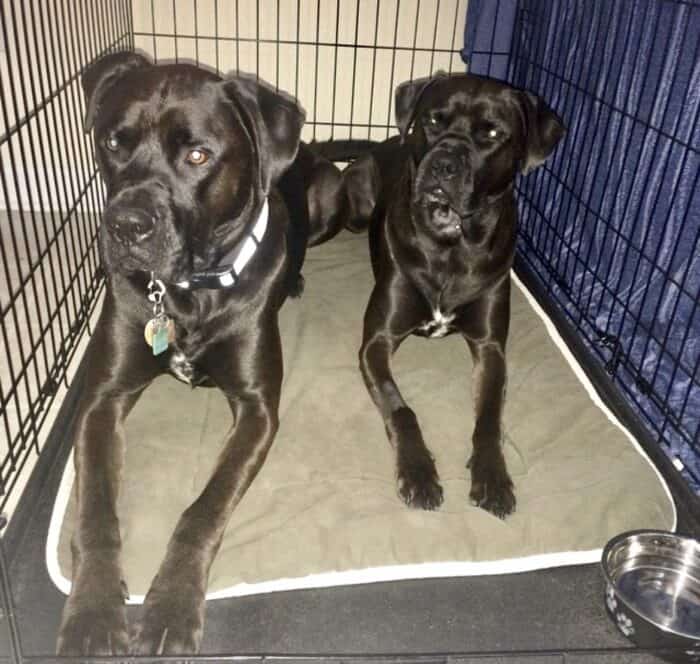
Then at nighttime, they would get crated with the crate door shut.
I use the same open-crate policy for my current pup Wally.
During the day, his crate stays open and then he spends the night in his crate with the door closed and a blanket covering the kennel.
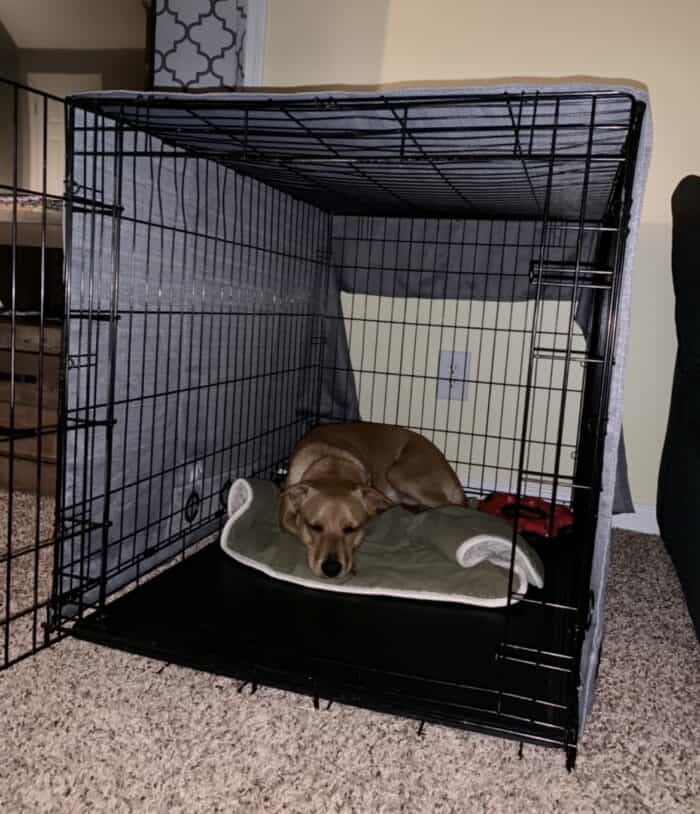
Alternatives To Crate Training
Most alternatives to crate training are specific setups at your home, but there’s also an option that involves spending the day out for your pup.
Remember that your dog will still need to be exercised prior to setting them up in the dog crate alternative at your home.
Additionally, they may also need a mentally engaging (chew) toy to keep them busy.
For example, a filled KONG or Nylabone dog toy. You can freeze both for an extra long-lasting activity.
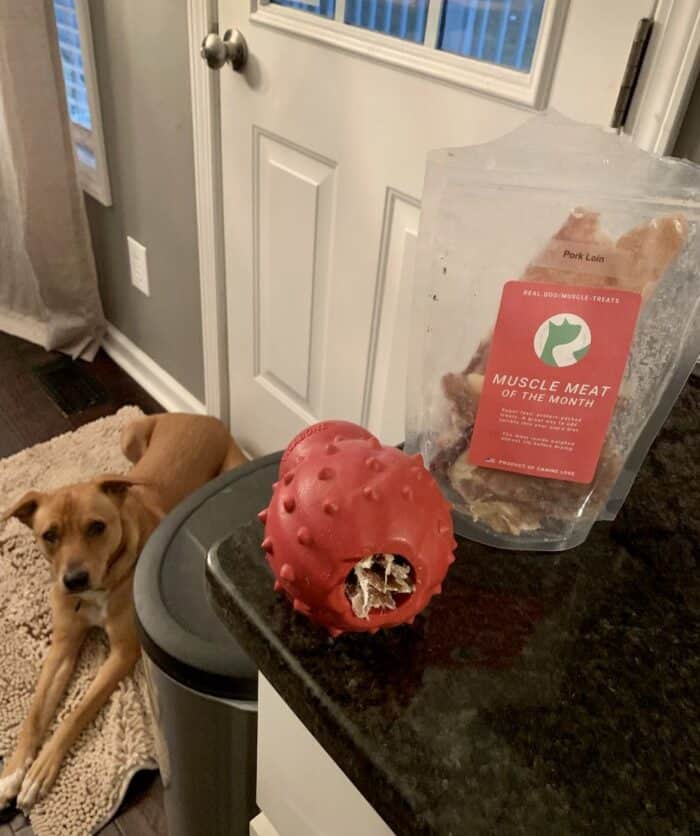
Last but not least, they’ll need just as many potty breaks as they would if they were crated.
Keeping that in mind, let’s start with the easiest alternative and end with the one that requires the most logistical efforts on your part.
Crate Alternative #1: Designated Doggie Room
It doesn’t get any easier than simply keeping your pup behind closed doors. All you have to do is decide on a room your dog can spend time alone in.
Ideally, you’ll want to choose a non-carpeted space. That will make it easier to clean up potential accidents. If your dog room has carpets, you may want to put down doggie pee pads.
Keep in mind that it shouldn’t be a huge room as this may entice your dog to lounge in one area of the room and take care of their doggie business in the far end.
This could be a laundry room, a small office space, or a bathroom.
Pro: Free, simple solution.
Con: Can cause scratched-up doors and door frames if your dog is bored.
Crate Alternative #2: Playpens
The next best option is to set up a doggie playpen somewhere in your home.
They come in different sizes, materials, and heights. That’s convenient as it gives you the option to choose a suitable crate for your respective pup.
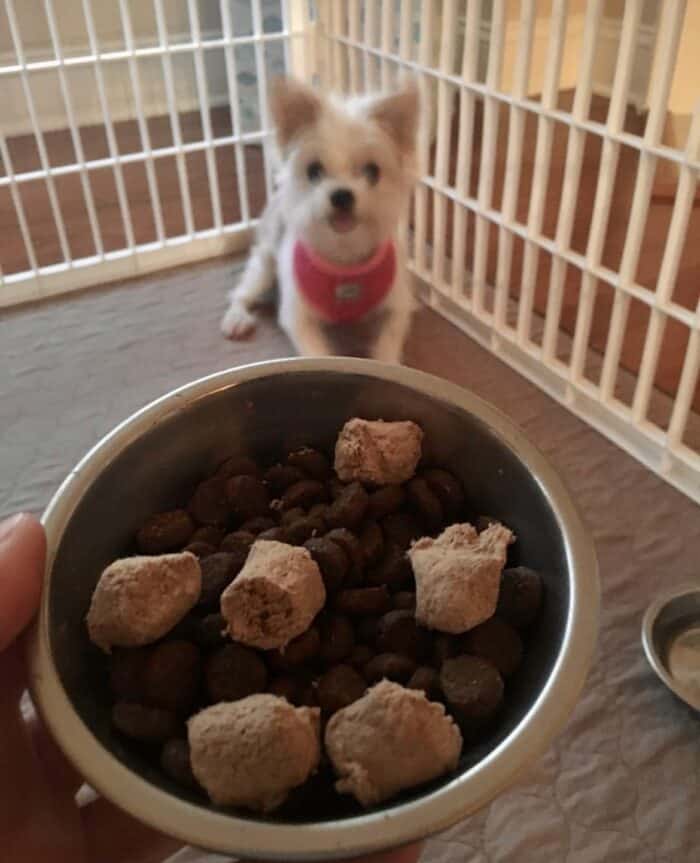
For example, a toy dog breed or small dog will do just fine with a foldable playpen made of mesh.
If your (small) pup chews or is teething, go for metal or hard plastic instead and provide them with an appropriate chew toy.
Pro: Inexpensive and easy setup.
Con: Some dogs may jump them or knock them over.
Colby used the Carlson Portable Pet Pen when he was raising Golden Retriever puppies. It worked well as a crate alternative for containing a litter of pups.
Take a look at this video of the using the Carlson Portable Pet Pen:
Crate Alternative #3: Gated Off Space
Another option is to use baby pet gates to keep your pup within a certain space in your home.
For example, the kitchen, laundry room, or bathroom.
It’s a more solid construction than a playpen because the gate sits between two walls or a door frame.
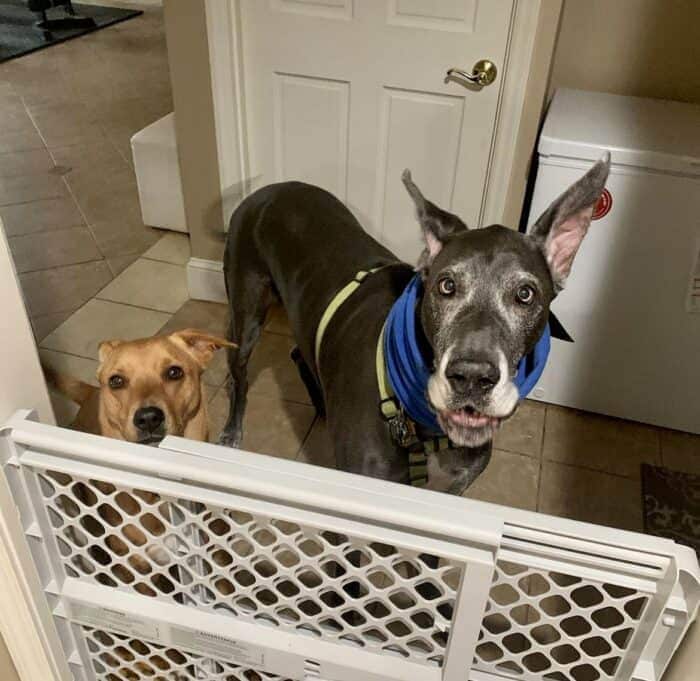
Similar to the dog room setup, it’s easiest to gate off a tiled space or one with hardwood floors in order to avoid accidents on carpeted areas.
Pro: Inexpensive and easy setup.
Con: Some dogs may jump the gate.
Crate Alternative #4: Doggie Daycare
We have one more option up our sleeves, but this one is a bit more time-consuming than the at-home alternatives to dog kennels: Doggie daycare.
Doggie daycare facilities can be really good crate alternatives if you don’t want to feel guilty about leaving your pup home alone, regardless of the setup. To find one close to you, just do a Google search.
They’re becoming more and more popular, so chances are there’s one not too far away from you!
For this setup to work, it’s best if your dog does well around other dogs.
Depending on the doggie daycare you take them to, your pup may have to pass a temperament test before you can drop them off at daycare.
That’s what Camp Bow Wow does, a known doggie daycare that has lots of facilities across the US.
Other doggie daycare facilities may provide one-on-one care for dogs who do better alone, but this depends on the respective daycare.
So make sure to call ahead of time or better yet, drop by to get a tour and ask any questions you may have.
Pro: Your dog’s being cared for by pet professionals and has doggie company.
Con: Can get expensive if used on a daily basis and requires dropping your pup off and picking them back up.
How Do You Fix Confinement Anxiety In Dogs?
If you’re looking for alternatives to crate training because your dog puts up a fight as soon as their space is restricted in any way, try to provide more physical and mental exercise before you leave them alone.
Combined, they burn the most energy which results in a tired dog. And we all know that tired dogs are good dogs, right?
An easy way of adding mental exercise components to a walk or run is to incorporate obedience commands and change direction frequently.
Why does that burn mental energy? Because your dog has to figure out what you want from them and pay attention to you.
Additionally, make confining them a positive experience, and try not to make a big deal when you’re leaving your pup.
Dogs pick up on our energy, and when they sense that you’re nervous or feel bad for leaving them, they’ll react nervously.
One way of making the experience a positive one is to toss a handful of yummy treats into your kennel substitute.
You can also feed your pup there.
When you come back home from your morning walk is actually a great opportunity to feed them breakfast as a way to avoid bloat.
Best Way to Potty Train a Puppy Without a Crate
If you’re looking to house-train your puppy without relying on a crate, your best bet is to use the playpen or baby gate options, as we just laid out.
Doggie daycares typically won’t be a good option as they require their canine campers to have had all of their puppy shots. By the time they have them, they’re usually already house-trained.
Regardless of which of the two alternatives to crate training you decide to go with, it’s best to be consistent with your approach to avoid confusing your puppy.
It’s also important to provide very frequent potty breaks to show your pup that bathroom breaks only happen outside.
That’s important because playpens and baby gates are almost always going to provide your puppy with more space than they would have in a crate.
With this setup, they’re more likely to use one end of their space to hang out and play, and the other to eliminate.
Good to know: Puppies need to potty right after they wake up from a nap, in between, and after playtime, as well as shortly after meals and drinking.
So if you can’t make it home that frequently, it’s important that somebody else does. This could be a trusted neighbor, friend, or pet sitter.
Bottom Line
While kennel training can be beneficial if it’s done correctly, it’s not the right approach for everyone.
As we’ve pointed out, there are several alternatives to crate training.
These alternatives include designated doggie rooms, playpens, baby gates as well as doggie daycare facilities.
Remember to be consistent in your training approach regardless of the substitute for crate training you’re using.
Physical and mental exercise are just as important as checking your own energy when you’re about to leave your dog!
Related Article:
Save To Pinterest
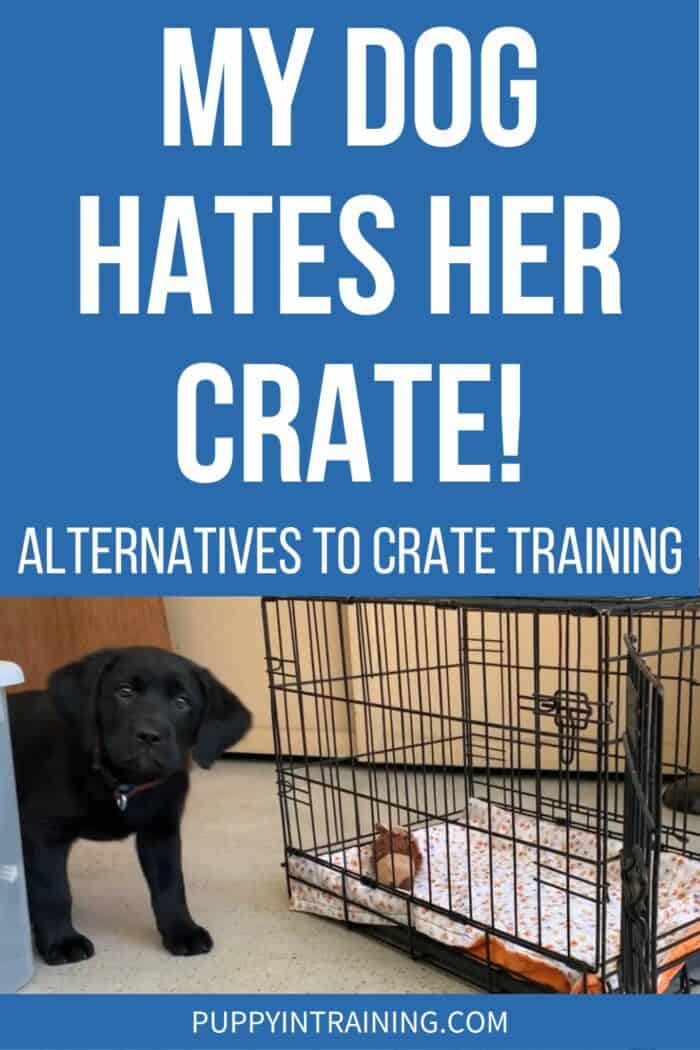
Top Picks For Our Puppies
- BEST DOG CHEW
We Like: Beef Collagen Sticks - All of our pups love to bite, nip, and chew. We love using Collagen Sticks to help divert these unwanted behaviors. - BEST PUPPY TOY
We Like: Calmeroos Puppy Toy w/ Heartbeat and Heat Packs - Perfect for new puppies. Helps ease anxiety in their new home. - BEST DOG TREATS
We Like: Crazy Dog Train-Me Treats - We use these as our high-value treats for our guide dog puppies. - BEST FRESH DOG FOOD
We Like: The Farmer's Dog - A couple months ago we started feeding Raven fresh dog food and she loves it! Get 50% off your first order of The Farmer's Dog.
Check out more of our favorites on our New Puppy Checklist.